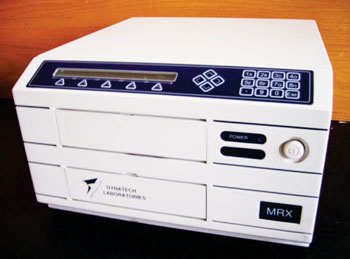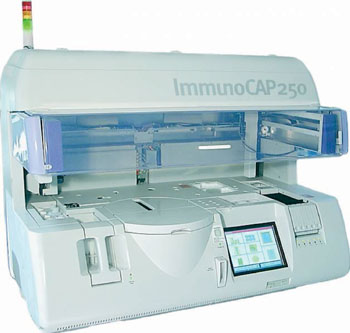Antibody Test Predicts Cold-Related Asthma Attacks
|
By LabMedica International staff writers Posted on 17 Dec 2014 |

Image: The MRX Microplate Reader for enzyme-linked immunosorbent assays (Photo courtesy of Dynatech Laboratories).

Image: The ImmunoCAP 250 analyzer for allergy and autoimmunity testing (Photo courtesy of Phadia).
A diagnostic marker can be used to identify the risk group for asthma attacks caused by rhinoviruses and this can be assessed with a simple antibody test.
Rhinoviruses (RVs) are the most common cause of respiratory illnesses in children and adults of all ages and are responsible for more than half of all acute exacerbations of asthma and chronic obstructive pulmonary disease (COPD).
Immunologists at the Medical University of Vienna (Austria) working with their colleagues in the UK studied the response to infections with RV16 that were induced in 28 asthmatic patients (11 with mild asthma and 17 with moderate asthma and 11 healthy adult individuals. The healthy adult subjects were non-smoking, non-atopic and non-asthmatic volunteers aged 21 to 55 years. Patients with mild asthma were aged 19 to 53 years taking only short-acting β2 agonists (SABA). The patients with moderate asthma, aged 20–54 years were on SABA) plus inhaled corticosteroid therapy.
Total immunoglobulin E (IgE) levels were measured using ImmunoCAP technology (Phadia; Uppsala, Sweden); healthy median: was 16 IU/mL; mild asthmatics median: was 207 IU/mL; and moderate asthmatics median was 132 IU/mL. Enzyme-linked immunosorbent assays (ELISA) were performed with expressed and purified recombinant RV coat proteins VP1-4, nonstructural proteins as well as N-terminal fragments of VP1 from four RV strains (RV14, 16, 89, C) covering the three known RV groups (RV-A, RV-B and RV-C) and measured specific IgG-subclass-, IgA- and IgM-responses in subjects with different severities of asthma or without asthma before and after experimental infection with RV16. The optical density (OD) values corresponding to the levels of antigen-specific antibodies were measured at 405 and 490 nm in an ELISA reader (Dynatech; Denkendorf, Germany).
The results of the subsequent antibody tests using recombinant virus antigens that were developed showed that the asthmatics who experienced attacks expressed significantly higher antibodies to the structure protein VP1, which is found in all of the known 150 or so rhinovirus strains, than any of the other subjects. The raised antibody response to VP1 now allows all individuals who need particular protection against colds to be identified.
The authors concluded that ultimately serological tests may be helpful for identifying the most common and clinically relevant rhinovirus strains involved in asthma exacerbations and to investigate in cross-sectional studies the possible role of rhinovirus infections in other respiratory diseases, in different geographic populations and age groups including not only children but also adults and elderly persons. The study was published on November 18, 2014, in the journal EbioMedicine.
Related Links:
Medical University of Vienna
Phadia
Dynatech
Rhinoviruses (RVs) are the most common cause of respiratory illnesses in children and adults of all ages and are responsible for more than half of all acute exacerbations of asthma and chronic obstructive pulmonary disease (COPD).
Immunologists at the Medical University of Vienna (Austria) working with their colleagues in the UK studied the response to infections with RV16 that were induced in 28 asthmatic patients (11 with mild asthma and 17 with moderate asthma and 11 healthy adult individuals. The healthy adult subjects were non-smoking, non-atopic and non-asthmatic volunteers aged 21 to 55 years. Patients with mild asthma were aged 19 to 53 years taking only short-acting β2 agonists (SABA). The patients with moderate asthma, aged 20–54 years were on SABA) plus inhaled corticosteroid therapy.
Total immunoglobulin E (IgE) levels were measured using ImmunoCAP technology (Phadia; Uppsala, Sweden); healthy median: was 16 IU/mL; mild asthmatics median: was 207 IU/mL; and moderate asthmatics median was 132 IU/mL. Enzyme-linked immunosorbent assays (ELISA) were performed with expressed and purified recombinant RV coat proteins VP1-4, nonstructural proteins as well as N-terminal fragments of VP1 from four RV strains (RV14, 16, 89, C) covering the three known RV groups (RV-A, RV-B and RV-C) and measured specific IgG-subclass-, IgA- and IgM-responses in subjects with different severities of asthma or without asthma before and after experimental infection with RV16. The optical density (OD) values corresponding to the levels of antigen-specific antibodies were measured at 405 and 490 nm in an ELISA reader (Dynatech; Denkendorf, Germany).
The results of the subsequent antibody tests using recombinant virus antigens that were developed showed that the asthmatics who experienced attacks expressed significantly higher antibodies to the structure protein VP1, which is found in all of the known 150 or so rhinovirus strains, than any of the other subjects. The raised antibody response to VP1 now allows all individuals who need particular protection against colds to be identified.
The authors concluded that ultimately serological tests may be helpful for identifying the most common and clinically relevant rhinovirus strains involved in asthma exacerbations and to investigate in cross-sectional studies the possible role of rhinovirus infections in other respiratory diseases, in different geographic populations and age groups including not only children but also adults and elderly persons. The study was published on November 18, 2014, in the journal EbioMedicine.
Related Links:
Medical University of Vienna
Phadia
Dynatech
Latest Immunology News
- Stem Cell Test Predicts Treatment Outcome for Patients with Platinum-Resistant Ovarian Cancer
- Machine Learning-Enabled Blood Test Predicts Immunotherapy Response in Lymphoma Patients
- Post-Treatment Blood Test Could Inform Future Cancer Therapy Decisions
- Cerebrospinal Fluid Test Predicts Dangerous Side Effect of Cancer Treatment
- New Test Measures Preterm Infant Immunity Using Only Two Drops of Blood
- Simple Blood Test Could Help Choose Better Treatments for Patients with Recurrent Endometrial Cancer
- Novel Analytical Method Tracks Progression of Autoimmune Diseases
- 3D Bioprinted Gastric Cancer Model Uses Patient-Derived Tissue Fragments to Predict Drug Response
- Blood Test for Fungal Infections Could End Invasive Tissue Biopsies
- Cutting-Edge Microscopy Technology Enables Tailored Rheumatology Therapies
- New Discovery in Blood Immune Cells Paves Way for Parkinson's Disease Diagnostic Test
- AI Tool Uses Routine Blood Tests to Predict Immunotherapy Response for Various Cancers
- Blood Test Can Predict How Long Vaccine Immunity Will Last
- Microfluidic Chip-Based Device to Measure Viral Immunity
Channels
Clinical Chemistry
view channel
‘Brilliantly Luminous’ Nanoscale Chemical Tool to Improve Disease Detection
Thousands of commercially available glowing molecules known as fluorophores are commonly used in medical imaging, disease detection, biomarker tagging, and chemical analysis. They are also integral in... Read more
Low-Cost Portable Screening Test to Transform Kidney Disease Detection
Millions of individuals suffer from kidney disease, which often remains undiagnosed until it has reached a critical stage. This silent epidemic not only diminishes the quality of life for those affected... Read more
New Method Uses Pulsed Infrared Light to Find Cancer's 'Fingerprints' In Blood Plasma
Cancer diagnoses have traditionally relied on invasive or time-consuming procedures like tissue biopsies. Now, new research published in ACS Central Science introduces a method that utilizes pulsed infrared... Read moreMolecular Diagnostics
view channel
Blood Test Could Predict Relapse of Autoimmune Blood Vessel Disease
Neutrophils, once believed to be uniform in nature, have been discovered to exhibit significant diversity. These immune cells, which play a crucial role in fighting infections, are also implicated in autoimmune... Read more
First-of-its-Kind Blood Test Detects Trauma-Related Diseases
In today’s fast-paced world, stress and trauma have unfortunately become common experiences for many individuals. Continuous exposure to stress hormones can confuse the immune system, causing it to misinterpret... Read moreHematology
view channel
New Scoring System Predicts Risk of Developing Cancer from Common Blood Disorder
Clonal cytopenia of undetermined significance (CCUS) is a blood disorder commonly found in older adults, characterized by mutations in blood cells and a low blood count, but without any obvious cause or... Read more
Non-Invasive Prenatal Test for Fetal RhD Status Demonstrates 100% Accuracy
In the United States, approximately 15% of pregnant individuals are RhD-negative. However, in about 40% of these cases, the fetus is also RhD-negative, making the administration of RhoGAM unnecessary.... Read moreMicrobiology
view channel
Handheld Device Delivers Low-Cost TB Results in Less Than One Hour
Tuberculosis (TB) remains the deadliest infectious disease globally, affecting an estimated 10 million people annually. In 2021, about 4.2 million TB cases went undiagnosed or unreported, mainly due to... Read more
New AI-Based Method Improves Diagnosis of Drug-Resistant Infections
Drug-resistant infections, particularly those caused by deadly bacteria like tuberculosis and staphylococcus, are rapidly emerging as a global health emergency. These infections are more difficult to treat,... Read more
Breakthrough Diagnostic Technology Identifies Bacterial Infections with Almost 100% Accuracy within Three Hours
Rapid and precise identification of pathogenic microbes in patient samples is essential for the effective treatment of acute infectious diseases, such as sepsis. The fluorescence in situ hybridization... Read morePathology
view channel
Sensitive and Specific DUB Enzyme Assay Kits Require Minimal Setup Without Substrate Preparation
Ubiquitination and deubiquitination are two important physiological processes in the ubiquitin-proteasome system, responsible for protein degradation in cells. Deubiquitinating (DUB) enzymes contain around... Read more
World’s First AI Model for Thyroid Cancer Diagnosis Achieves Over 90% Accuracy
Thyroid cancer is one of the most common cancers worldwide, and its precise management typically relies on two primary systems: (1) the 8th edition of the American Joint Committee on Cancer (AJCC) or ... Read more
Breakthrough Diagnostic Approach to Significantly Improve TB Detection
Tuberculosis (TB) remains the deadliest infectious disease globally, with 10.8 million new cases and 1.25 million deaths reported in 2023. Early detection through effective screening is crucial in identifying... Read more
Rapid, Ultra-Sensitive, PCR-Free Detection Method Makes Genetic Analysis More Accessible
Genetic testing has been an important method for detecting infectious diseases, diagnosing early-stage cancer, ensuring food safety, and analyzing environmental DNA. For a long time, polymerase chain reaction... Read moreTechnology
view channel
Disposable Microchip Technology Could Selectively Detect HIV in Whole Blood Samples
As of the end of 2023, approximately 40 million people globally were living with HIV, and around 630,000 individuals died from AIDS-related illnesses that same year. Despite a substantial decline in deaths... Read more
Pain-On-A-Chip Microfluidic Device Determines Types of Chronic Pain from Blood Samples
Chronic pain is a widespread condition that remains difficult to manage, and existing clinical methods for its treatment rely largely on self-reporting, which can be subjective and especially problematic... Read more
Innovative, Label-Free Ratiometric Fluorosensor Enables More Sensitive Viral RNA Detection
Viruses present a major global health risk, as demonstrated by recent pandemics, making early detection and identification essential for preventing new outbreaks. While traditional detection methods are... Read moreIndustry
view channel
Cepheid and Oxford Nanopore Technologies Partner on Advancing Automated Sequencing-Based Solutions
Cepheid (Sunnyvale, CA, USA), a leading molecular diagnostics company, and Oxford Nanopore Technologies (Oxford, UK), the company behind a new generation of sequencing-based molecular analysis technologies,... Read more
Grifols and Tecan’s IBL Collaborate on Advanced Biomarker Panels
Grifols (Barcelona, Spain), one of the world’s leading producers of plasma-derived medicines and innovative diagnostic solutions, is expanding its offer in clinical diagnostics through a strategic partnership... Read more



















